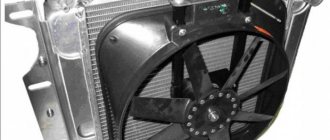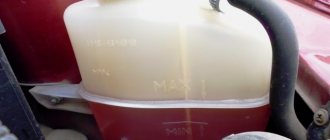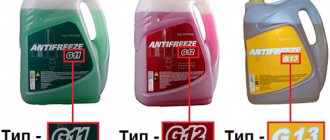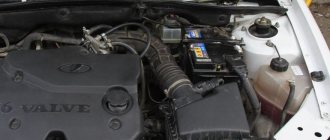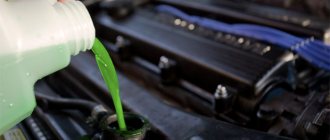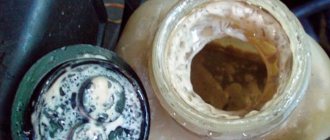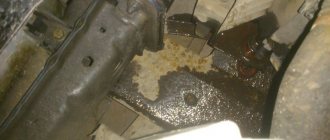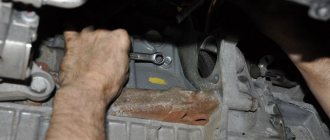Constant boiling of liquid in the car's cooling system should be taken as a serious malfunction, since it threatens to overheat the power unit. It is noteworthy that the phenomenon can arise due to minor problems, but lead to disastrous consequences if the defect is not corrected in a timely manner. Why antifreeze boils in the expansion tank of a car and what ways to deal with the malfunction is described in this publication.
How dangerous is bubbling antifreeze?
This phenomenon is considered normal when the engine is warmed up to an operating temperature of 90–95 °C, provided that there are no losses of coolant, leaks outside the tank and other abnormal signs. Part of the antifreeze circulating in a large circle is discharged into the expansion tank. To an inexperienced car enthusiast, it may seem that it is boiling, although in reality an intense discharge is taking place.
Important point! A sign of serious danger to the engine is an increase in coolant temperature. If the device does not show it, overheating is excluded.
Not all seething is harmless. If it occurs on a cold engine and is accompanied by side symptoms, there is a reason to check the condition of the cooling system. What these signs and possible malfunctions look like:
- Antifreeze suddenly begins to bubble 2–5 minutes after stopping the engine. Most likely, the problem is a faulty valve built into the radiator cap. When circulation stops, the fluid in the cylinder head quickly heats up and increases in volume. Since the radiator valve is open, it rushes into the tank through the upper outlet pipe.
- Seething and drips on the expansion tank body indicate a stuck plug valve. Air and steam break out at a weak point - along the plastic thread, but they can also “explode” the container.
- There is a large amount of white smoke coming out of the exhaust pipe, and streaks are visible on the cylinder block. The reason is a broken gasket between the block and the cylinder head. The gas pressure created by the pistons is transmitted to the cooling system, causing the antifreeze to bubble and boil in the expansion tank.
Note. Often, a crack in the gasket connects the water channels with the oil channels. Then a foamy substance is noticeable in the container - an emulsion whipped by a pump.
It is not difficult to guess that a breakdown of the cylinder head gasket is a critical malfunction that must be corrected immediately. Problems with covers and built-in valves are not so fatal, but they lead to large losses of antifreeze and the same overheating, as indicated by frequent turning on of the fan.
Boiling due to overheating
To begin with, we should separate 2 concepts - boiling of coolant as a result of overheating and bubbling of antifreeze in the expansion tank. The first malfunction is accompanied by a temperature jump above 115 °C (with such heating, the coolant begins to boil) and occurs due to the following reasons:
- the thermostat damper is stuck in the slightly open position, the liquid moves along a small circuit and does not have time to cool;
- the sensor that turns on the electric fan has failed;
- the honeycombs of the main radiator are heavily clogged;
- an air lock has formed in the system, preventing normal circulation;
- the pump shaft is jammed or broken, the pump impeller has crumbled;
- antifreeze is too diluted with water boiling at 100 °C.
If the coolant boils for one of the above reasons, the engine overheats and may fail at any time.
When exposed to high temperatures, aluminum pistons increase in diameter and lift up steel cylinder liners. A driver who notices the readings of the coolant temperature gauge and does not turn off the engine runs the risk of changing the piston group with the cylinder bore, sometimes along with the crankshaft. When you notice a critical jump in the thermometer needle on the dashboard to a temperature above 110 ° C, immediately stop the engine and find out the causes of boiling and overheating. Premature major repairs are not cheap.
Consequences of boiling
What happens if the car engine boils? The consequences of engine overheating can be the most tragic for a car.
There are several degrees of engine overheating that occur as a result of boiling liquid:
- slight overheating of the motor;
- average engine overheating;
- severe overheating of the motor.
Slight overheating. If the overheating of the engine as a result of antifreeze boiling does not exceed 10 minutes, then the car owner can be said to be very lucky. This may occur if the fan or thermostat fails. If you notice the engine overheating in time (according to the temperature sensor on the instrument panel), then you should turn off the car as quickly as possible. In this situation, the worst thing would be if the engine pistons start to melt.
But this is not scary, especially for owners of new cars. As a rule, in new cars the consequences of such overheating will not be noticeable. You need to start panicking and take your car for repairs if you clearly see smoke starting to appear from under the hood.
Refrigerant boiling in the expansion tank
Medium overheating occurs if the boiling time of the liquid exceeds 20 minutes. In this case, the driver may face the following consequences:
- cylinder heads may become bent;
- cracks may appear on the cylinder head;
- cylinder block gaskets will melt or burn out;
- destruction of the inter-ring partitions on the engine pistons;
- Engine oil will begin to flow through the seals.
The two stages of overheating described above often occur as a result of poor or inattentive vehicle maintenance. But severe engine overheating from boiling antifreeze can be a real “heart attack” for your car.
If “Tosol” boils and the engine is very overheated, then the consequences, as a rule, cover all parts of the engine. But this is not the saddest outcome of events. The worst thing that can happen is if the motor explodes as a result of overheating. But this rarely happens, since often the car system allows the driver to avoid such a decoupling - the engine components are destroyed at different rates, as a result of which it simply stalls. The so-called “wave of destruction” extends to the entire motor and other components surrounding it:
- the pistons begin to melt and burn;
- molten metal from the pistons drips onto the cylinder walls, as a result of which the movement of the piston becomes difficult. Accordingly, the piston quickly fails and becomes unusable;
- if the car does not stall due to broken pistons, problems with the engine fluid may begin;
- overheated motor fluid immediately loses its lubricating properties, as a result of which all rubbing parts gradually begin to fail;
- after this, melted elements begin to stick to the crankshaft, which also complicates its operation;
- when the valve seats fly out, the crankshaft simply breaks into several parts under the influence of the piston;
- after this, the piston can pierce one of the walls of the cylinder block, and this, in turn, leads to complete engine failure.
Why does antifreeze boil in the expansion tank on a VAZ-2110?
Antifreeze is one of the main coolants used in modern cars. It has good technical characteristics and an optimal price, which is why it has become so widespread. Antifreeze contains antifreeze, so it can be used at any time of the year. Different brands of coolant are tinted using dyes in different colors. This allows the driver to easily distinguish them from each other, even if the label is lost or erased.
Causes of malfunction
When antifreeze boils, the reasons for this phenomenon may be different. Experienced motorists are well aware of them . The most common :
- low level of coolant in the expansion tank;
- a malfunction in the thermostat;
- clogged radiator.
We recommend: Is it possible to mix antifreeze with antifreeze?
In any of these cases, the antifreeze is not able to cool quickly. His temperature is constantly rising. When this indicator reaches 120 degrees Celsius, the boiling process begins. This leads to a situation where the antifreeze begins to boil away.
Ethylene glycol is the main component of any coolant. This substance is a chemical compound that belongs to the group of alcohols. It is its presence that ensures the liquid state of the product in the cold. When it boils, the process of evaporation of ethylene glycol occurs. The main danger of this process is that the vapors of the substance are toxic and pose a serious threat to the human nervous system .
Low antifreeze level
If a car owner is faced with a problem such as antifreeze boiling on a VAZ-2114, then he first needs to check the level of technical fluid in the tank. However, this procedure should be carried out only after the antifreeze has completely cooled. If a deficiency is detected, then, depending on the situation, the following manipulations must be performed:
- If antifreeze has not been poured into the cooling system for a long time, it could simply leak out. If the level is low, it is necessary to top it up to bring the amount of technical fluid to the required level. When this is done, you can continue moving.
- In a situation where antifreeze was recently poured into the cooling system, and its level dropped to a critically low level, it is necessary to pay attention to the structural integrity of the tank. You should also inspect all pipes, as well as hoses and clamp connections for leaks of technical fluid. If a leak has been discovered, and there is no way to solve the problem right on the spot, then you need to use the service of a tow truck and drive to the nearest car service center.
If the level of antifreeze in the system is low, you cannot continue driving. Otherwise, you may encounter serious problems with the operation of the motor. Eliminating them can be costly.
Thermostat failure
As part of the cooling system, the thermostat acts as a device that regulates the temperature of the antifreeze. It is thanks to it that accelerated heating of the power unit is ensured. This device also allows you to maintain the required thermal conditions during its operation.
When the thermostat breaks down or the valve simply gets stuck in one position, the large circuit stops working. In such cases, antifreeze circulates only in a small circle. However, this does not allow it to cool completely. To determine if this part is broken, you need to turn off the engine and then open the hood. You should find the thermostat pipes and touch them carefully to avoid getting burned.
If the pipe connected to the main radiator is hotter than the others, this may indicate some kind of problem with the operation of the device. In this situation, the most reasonable solution is to travel to the nearest service station to replace the device.
Even with such a malfunction, you can continue moving further, but at low speed. In this case, every 5 km you should stop and perform the procedure of adding water to the expansion tank. But this operation can be carried out only after the power unit has cooled. Then you can easily get to the service center and replace the faulty device.
Radiator problems
Antifreeze boiling can also occur if the radiator stops working. This malfunction may occur in the following cases:
- During operation, a layer of scale may appear on the tubes of the product. This leads to the fact that their thermal conductivity is noticeably reduced. When the number of clogged pipes increases, the ability of the radiator to cool the antifreeze passing through it decreases.
- There is dirt in the radiator or the tubes are completely clogged. If such a problem occurs, it leads to a decrease in coolant circulation. In advanced cases, this process stops altogether. As a result, the temperature of the antifreeze increases - it boils.
- A problem with the radiator can also arise if the fan fails. Then the product does not have the ability to cool the antifreeze to the required temperature. The car owner can independently determine that the malfunction occurred in the fan. This can be done by ear. If the car engine is quiet when starting, it means it is not turned on.
In any of these cases, you can continue moving, but there is one caveat. It is necessary to stop every 8 km to allow the engine to cool down. Otherwise, problems with the engine cannot be avoided.
Coolant: features and purpose
There are several types of coolant that have the same principle of operation and differ only in shade. You can find out exactly what product to pour into your car from the manufacturer’s recommendations. The coolant must be replaced at least once every 4 years. But in some cases this needs to be done more often, depending on its density. It is measured with a special device that shows what minimum temperature antifreeze can withstand. Most of these liquids are designed to work in conditions at temperatures of at least -30 degrees. When used in extreme conditions, antifreeze can only withstand a year of operation, after which it will have to be changed.
Motor oil poured into the engine is checked with a special dipstick, which is inserted into a separate hole. These tools are not required to check the coolant. You can find out its level visually. On the walls of the expansion tank, where the antifreeze is located, there are special marks marking the maximum and minimum filling levels. If the liquid is in the middle, there is no need to add it.
It is necessary to check the coolant only when the engine has cooled down, and it is better to do this before leaving the garage. If after inspection a drop in the antifreeze level is noticed, then most likely there is a leak and the system has depressurized. If you can’t find the location of the damage yourself or don’t have time, you need to fill the tank full and monitor whether the level drops. If the liquid continues to leak, you should contact a car service. To add antifreeze, you need to open the reservoir cap and use a funnel to fill it to the required level. Then you need to start the car and wait a few minutes. If the liquid level does not decrease, you can close the lid and start moving.
Antifreeze (antifreeze) is a toxic liquid, so it is necessary to protect your eyes and exposed skin from getting it. It is impossible to drain the liquid when replacing it to the ground; it is better to use a special container for this. Subsequently, it can be handed over for recycling to a special enterprise. If necessary, you need to replace the antifreeze. To drain the old fluid, you need to unscrew the tap or plug located at the bottom of the power unit. You will also need to drain it from the expansion tank and radiator. To carry out this procedure, you need to slightly unscrew the tank cap. This way the liquid will flow out more actively.
Then the plug is unscrewed and the coolant is drained from the engine cooling jacket. You should first prepare a container of the appropriate size and place it under the drain hole. The drain valve or the lower plug must also be unscrewed from the radiator. The drainage speed can be adjusted by twisting or tightening the tank lid. When the procedure is completed, all plugs are tightened again.
If there are contaminants in the system that interfere with the movement of antifreeze and prevent heat transfer, you can flush it. Previously, vinegar essence and citric acid were used for this. Now you can purchase special compositions - washing concentrates.
Preventive measures
To avoid cooling system malfunctions, you need to buy high-quality antifreeze from trusted auto stores and services. If everything worked before replacing the antifreeze, but after the replacement the system boiled, most likely the reason was poor-quality antifreeze.
A sign of fake antifreeze is its boiling over at a temperature on the dashboard of 90 °C. In this case, if the VAZ 2114 boils at 90 degrees, a complete drain of the fake and flushing of the entire cooling system is required.
When purchasing antifreeze, you need to pay attention to both the boiling point and boiling pressure. If the pressure does not match atmospheric pressure, recalculate the temperature. For example, at the promised 135°C-1.2 atm. antifreeze will boil at 100°C-1 atm (if the atmospheric pressure is normal, it will boil at 100°C).
During a daily inspection of the engine compartment with the engine running, you can detect fluid leaks, ruptures in connecting pipes and contamination of the radiator.
To prevent the engine from overheating, you need to set the fan activation temperature on the on-board computer to 95°C (change from the factory setting to 102-105°C).
What not to do
There are several simple rules that should be followed when the coolant boils. By following them, you will protect yourself from possible injuries (burns), and the engine from the need for major repairs:
- reduce the speed to a minimum, do not accelerate so that the engine does not experience stress;
- after stopping, do not turn off the engine immediately, let it run for at least a minute or two;
- Having opened the hood, do not touch the parts and assemblies, as they are very hot;
- do not water the power unit with cold water - a sharp temperature change will not lead to anything good, and it can also cause a short circuit in electrical equipment; it is necessary to wait for the engine to cool down on its own, gradually, with natural air flowing around it;
- After the engine has cooled down and coolant has been added, you cannot continue driving when the temperature reaches more than 90 degrees.
Compliance with these requirements will protect the driver and reduce the material costs of restoring normal engine performance.
If you have any questions, leave them in the comments below the article. We or our visitors will be happy to answer them
Air blockage
If air gets into the cooling system, a pneumatic plug is formed, due to which antifreeze simply does not circulate through the radiator. Mostly this occurs when small holes appear in the pipes or in the radiator itself (air is “sucked in” through them). In this case, antifreeze almost immediately boils in the expansion tank after starting the engine.
Repair involves eliminating the hole; the easiest way to find it is through a thorough inspection of the cooling system with the engine running. It is necessary to find exactly where the liquid is leaking.
Cover with a secret
The cap of the expansion tank of the VAZ-2110 is a separate element of the system for a reason. It is this that prevents the coolant from boiling by maintaining the required pressure. The expansion tank VAZ-2110 is equipped with a lid, the design of which includes a two-way spring-loaded valve. It opens and releases vapors when the pressure inside the tank reaches 1.1-1.5 kgf/cm. Its opening in the opposite direction occurs at 0.03-0.15 kgf/cm (with the motor cooling).
Both antifreeze and antifreeze at normal (atmospheric) pressure boil when heated to 100 C. But as we have already said, in the cooling system the working pressure is 1.1-1.5 kgf/cm. Under such conditions, the coolant will boil at no less than 130 C. It is to ensure that the coolant does not overheat before the radiator fan turns on that a cap with a valve is needed. So if the expansion tank of a VAZ-2110 boils at normal engine temperature, you can be sure: it is definitely to blame. Naturally, if the refrigerant temperature sensor is working properly.
About the operation of the cooling system
Without understanding the operating principle of the cooling system, it is difficult to diagnose the causes of problems and make repairs. The scheme operates according to the following algorithm:
- Until the engine is warmed up, antifreeze (antifreeze) circulates through a small cooling circle, which includes the engine water jacket, heater and thermostat. The fluid level (abbreviated as coolant) in the expansion tank remains within normal limits.
- As the engine heats up, the thermostat opens a large circulation circuit through the main radiator. The antifreeze in the system expands and its excess enters the tank. The increasing pressure is released by the bypass valve of the cover.
- When 95°C is reached, all liquid passes through the main radiator and expands to its maximum volume. The excess is discharged through the additional upper radiator pipe, so it seems that the antifreeze is boiling in the container.
- Cooling of the power unit leads to compression of the coolant to its original volume and a drop in pressure. To prevent vacuum from occurring, the bypass valve of the expansion tank plug allows outside air into the system.
Reference. Some car models provide for 2 discharges of excess antifreeze into the tank - from the radiator and the cabin heater.
Depending on the design of the cooling system, the cap with the valve is installed on the expansion tank or the radiator neck. In the second case, liquid discharge begins after a certain pressure is exceeded, and the tank is constantly connected to the atmosphere through a hole in the plug.
Coolant selection
First, you need to figure out how much coolant is provided in the VAZ 2110. This will allow you to purchase the required amount of antifreeze and correctly carry out the replacement procedure.
So, the expansion tank should be filled with 7.8 liters of coolant. Although in reality, when draining, you will only get about 7 liters. Part remains inside. Therefore, when filling, there is no need to fill all 7.8 liters. 7 liters is enough.
We have already understood how much coolant is provided in the VAZ 2110, and how much needs to be filled. So it's time to choose.
In order to make a smart purchase of a new antifreeze, follow a few simple rules.
- Purchase a liquid with the same characteristics, color and production that was used previously. Of course, if the previous coolant worked effectively. Mixing different types of antifreeze is a common mistake that can lead to unpredictable consequences.
- Take a closer look at the packaging of the liquid you purchased. Today they sell both ready-to-fill formulations and concentrates, which must be diluted before use.
- Replace antifreeze only when the engine has completely cooled down.
- Start the engine after replacing the coolant strictly after all connections are made and the expansion tank cap is closed.
What to do in case of boiling?
If Antifreeze is boiling, smoke is coming from under the hood, and the engine temperature gauge needle shows more than 100 degrees, then you need to do the following:
- First you need to immediately stop loading the motor. That is, you need to engage neutral gear and move until it comes to a complete stop, without turning off the engine. At the same time, turn on the heater or fan so that the engine cools down at least a little;
- After stopping the vehicle, the engine must be turned off, but the stove does not need to be turned off. A working heater will allow the engine to cool down a little;
- open the hood of the car to provide airflow to the engine;
- then you need to wait 20-30 minutes;
- It is strictly not recommended to open the expansion tank with coolant, otherwise hot antifreeze may simply spray out of it and burn the driver’s skin;
- when 30 minutes have passed, look for someone to take you to the service station. You can take the car towed or call a tow truck;
- if going to a service station is not an option, then open the expansion tank and add refrigerant, then close the hood and drive to the nearest service station with the heater on. Look how much fluid is in the expansion tank. If it is not there, then do not rush to fill in the refrigerant: sudden cooling is harmful to the system. In this case, it is necessary to control the engine temperature: if it exceeds 100 degrees, then stop the car and wait until the temperature drops. If the temperature goes beyond 100 degrees several times, then there is a possibility of motor failure. If the engine misfires, then it is necessary to change the gasket on the cylinder block;
Sediment in the pipe after using low-quality refrigerant
If you have the necessary knowledge, you can try to fix the breakdown on the spot.
To do this, you need to diagnose the parts and, if necessary, replace:
- thermostat;
- clean the cooling radiator;
- replace the pump;
- change the fan;
- disconnect the pipes from the thermostat and get rid of the air lock;
- Replace the antifreeze temperature sensor.
It is better to entrust such work to a specialist if you are not confident in your abilities. The temperature of the engine must be constantly monitored to prevent such malfunctions from occurring, but if it boils, then follow the steps described above.
Why does antifreeze boil in the expansion tank on a VAZ-2110?
Boiling of coolant in a car engine indicates a complete failure of the system. This is a rather serious symptom , although the cause of boiling may be trivial. Nevertheless, a violation of the temperature regime of the engine can lead to failure of both the entire engine and its main components and assemblies. If antifreeze boils despite normal temperature sensor readings, we immediately begin troubleshooting.
Danger of boiling antifreeze
If antifreeze boils in the expansion tank, some drivers do not worry about this. After all, experts consider such a process to be quite normal, especially if the power unit is heated to a temperature of 90-95 degrees Celsius.
But if the antifreeze is boiling, then there should be no loss of it, as well as leaks and other signs. When the technical fluid circulates in a large circle, some of it is discharged into a container intended for this purpose. Novice motorists in such a situation may consider that the antifreeze has boiled. But in fact, something completely different happened: excess fluid was dumped.
But not every bubbling of antifreeze can be called safe for the “health” of the engine. If this happens when the power unit is in a cold state, and side symptoms appear, then this is a serious reason to check the condition of the system. The main signs that eloquently indicate the presence of a malfunction are:
- 2-5 minutes after stopping the engine, the water in the expansion tank boils. The main cause is a faulty valve built into the radiator cap. After the circulation of antifreeze stops, the liquid accumulated in the cylinder head heats up quite quickly and increases in volume. This happens because the radiator valve is open. Therefore, antifreeze rushes into the tank, moving along the upper discharge pipe. Boiling or detection of smudges on the body of the working container may indicate that the plug valve is simply stuck. In this case, vapor and air can escape through the weakest point in the container (the plastic thread of the valve). This may cause the vessel to burst.
- If the owner observes white smoke in a fairly large volume from the exhaust pipe, while smudges are noticeable on the cylinder block, this indicates that the gasket between the block and the cylinder head has been broken. The gas pressure created by the pistons is transmitted to the cooling system. This is what leads to the antifreeze bubbling and boiling. It is clearly visible in the tank. Even a beginner understands that if the cylinder head gasket is blown, then the problem is critical and must be fixed immediately.
Problems with the reservoir cap and built-in valves are not serious problems. But still, one should not take such problems lightly. Otherwise, antifreeze will begin to quickly leave the system. They can also cause overheating of the power unit. If this happens, the fan will turn on very often while driving.
Troubleshooting Methods
If antifreeze boils during a trip, and the thermometer needle shows a temperature of 110 degrees Celsius, then you must immediately turn off the power unit, and then check the following significant points:
- You need to touch the bottom of the radiator with your hand. If it is cold, then the problem is related to the thermostat. You should wait a while until the engine cools down. Or, at low speed, you can continue driving to the nearest service station. If the thermostat is broken, it can only be replaced. Such devices cannot be repaired.
- If the cause of the malfunction is related to the electric fan, then the solution to the problem is to connect it directly to the battery. After this, you need to continue to the nearest auto electrician. A specialist will be able to accurately determine the cause of the breakdown and eliminate it.
- If the antifreeze boils due to a severely clogged radiator, then the possible cause of the problem can only be determined after disassembling the system.
Motorists often encounter problems such as pump jamming. Its appearance may be accompanied by bubbling of antifreeze in the expansion tank. When this happens, a temperature spike occurs and a leak appears in the area where the water pump seal is located. In this case, you need to spend money on replacing this part. It is unacceptable to continue driving with a faulty pump.
Antifreeze boiling is a fairly common problem, especially in the summer. It often occurs due to a dirty radiator. If, due to a broken cylinder head gasket, the coolant begins to bubble, then the best thing you can do is call a tow truck and get to a service station. Specialists will help determine the cause of the problem and eliminate it. After some time, the cooling system will function normally and you can safely move around the city streets without fear of problems with the engine.
Basic functions of antifreeze
What is antifreeze? This is the liquid that circulates in the cooling and heating system of a car. It removes excess heat from the engine and, if necessary, heats the interior. Antifreeze (antifreeze) contains antifreeze and anticorrosion additives. Usually the number after the brand name indicates the freezing point of the antifreeze.
The boiling point of high-quality antifreeze is +108-125 °C. This temperature is maintained with a sealed and properly functioning system.
Over time, antifreeze loses its qualities and must be changed regularly (at least once every 3-5 years).
If signs of boiling appear, stop and cool the engine. If you know that the shelf life of the antifreeze in the system is fine, you need to look for why the antifreeze is boiling in the expansion tank of the VAZ 2114.
If antifreeze is boiling, it is better to get to the nearest car service center as quickly as possible. Otherwise, the cooling system and an overheated engine will require serious repairs and investment. With frequent boiling, the service life of the engine is reduced by 2-3 times.
Low ambient pressure
You may encounter something similar while traveling. The fact is that the higher the car is above sea level, the lower the boiling point of the coolant. These are the simplest laws of physics, known from school.
If at an altitude of 0 meters above sea level the boiling temperature is in the range of 100 - 110 degrees, then at an altitude of 2.5 - 3 km antifreeze will begin to boil at 85 - 90 degrees. But the engine should not overheat. This is not a breakdown, but a natural behavior of the coolant.
Precautionary measures
The driver must know that:
- When antifreeze is boiling, it is strictly forbidden to open the cap of the expansion tank or the radiator neck, as you can get extensive burns due to the massive cloud of hot steam.
- You cannot check the heating of pipes and radiators with your palm turned on. For this, either thermocouples or thermometers with infrared sensors are used.
- Antifreeze is a toxic substance. Under no circumstances should you “taste” it. Even a few drops can lead to very serious consequences.
In total, the above reasons are the most common, which is why antifreeze begins to boil or simply “bubble” in the expansion tank. If you cannot determine the nature of the breakdown yourself, then it is better to contact experienced specialists from a service station. But you shouldn’t allow the engine to overheat regularly, since repairing a jammed cylinder block is not a cheap “pleasure.”
What can a breakdown lead to?
We found out that the unpleasant odor is caused by a coolant leak. This leads to overheating of the engine - which can result in breakdown. Fumes are harmful to health - especially in the cold season, when the smell of antifreeze in the cabin only intensifies when the heater is turned on. Therefore, in winter, the malfunction must be eliminated even more quickly. You can do it yourself, but if you don’t have the skills, it’s better to turn to the experts.
A malfunction can add the following problems:
- Carpet, ceiling upholstery, sound insulation and other materials inside the cabin actively absorb and accumulate odors. Over time, they will become saturated with the unpleasant smell of antifreeze. It will always accompany the driver; no fan will help here.
- The coolant will leak out all the time - you will have to spend money on constant replenishment.
- The antifreeze that has dried after leaking crystallizes; these unnoticeable “crystals” will “flavor” the car’s interior.
It is not easy to determine the fact of a leak if the coolant gets under the timing drive. But upon careful inspection of the space under the belt, characteristic marks can be detected. Antifreeze can also get on the belt itself. This will cause the destruction of its structure. Typically, the cause of moisture on the timing belt is a faulty pump.
Prevention
From time to time, you should prevent engine overheating in order to avoid unpleasant situations in the future. In terms of costs, this costs little money, but in the end it can save the engine from breakdown. You can identify the “weak link” by eliminating, gradually checking suspicious parts for malfunction.
In addition, overheating of the engine can occur if the wrong mode of operation of the motor is selected. For example, if you constantly drive only in lower gears and at high speeds, then the likelihood of the engine boiling increases, especially if there are deviations in the operation of the cooling system. In the cold season, some errors are not affected by low temperatures, but this does not mean that engines boil only in the summer.

